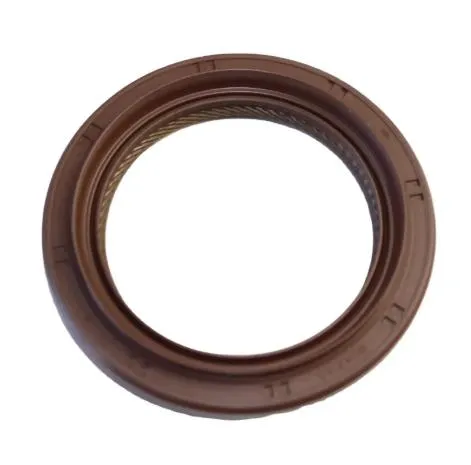Understanding Crankshaft Oil Seals: Types, Functions, and Common Issues
Crankshaft oil seals are small yet critical components in an internal combustion engine. These seals prevent oil leakage from the crankcase and ensure the engine remains properly lubricated. This article delves into the different types of crankshaft oil seals, their locations, roles, and signs of failure. We'll focus particularly on the front crankshaft seal, rear crankshaft seal, and general terms like crank seal, front main seal, and crankshaft oil seal.

What Is a Crankshaft Oil Seal?
The crankshaft oil seal is a circular rubber or polymer seal fitted at each end of the crankshaft. Its primary function is to prevent engine oil from leaking where the crankshaft exits the engine block—both at the front and rear.
These seals must withstand high rotational speeds, pressure, and temperature variations. They’re reinforced with metal and often include a spring-loaded lip to maintain tight contact with the rotating crankshaft.
There are two main crankshaft oil seals:
Front crankshaft seal (also called front main seal)
Rear crankshaft seal (or rear main seal)
Each plays a vital role in maintaining engine integrity and performance.
Front Crankshaft Seal (Front Main Seal)
The front crankshaft seal is located at the front end of the engine, behind the harmonic balancer or crankshaft pulley. It's also known as the front main seal.
ఫంక్షన్
Seals the crankshaft where it exits the front of the engine.
Prevents oil from leaking around the crank pulley.
Keeps the timing belt or chain area free from contamination.
Common Issues
Oil leaks near the timing cover or crank pulley.
Whining or squealing noise from the front of the engine.
Premature belt or accessory failure due to oil contamination.
Causes of Failure
Age-related rubber degradation.
High crankcase pressure.
Poor installation or misalignment.
Contamination by dirt or old oil.
Replacing the front crank seal involves removing accessories like the serpentine belt and crankshaft pulley. While it’s a relatively inexpensive part, labor can be intensive.
Rear Crankshaft Seal (Rear Main Seal)
The rear crankshaft seal, or rear main seal, is located at the back of the engine, where the crankshaft connects to the transmission.
ఫంక్షన్
Seals the rear of the crankshaft to prevent oil from leaking into the bell housing.
Maintains oil inside the engine and away from the clutch or torque converter.
Symptoms of a Failing Rear Seal
Oil dripping between engine and transmission.
Clutch slippage (in manual transmission vehicles).
Unexplained oil loss with no visible leaks elsewhere.
Causes of Rear Seal Failure
Worn crankshaft or seal surface.
Excess crankcase pressure from PCV system failure.
Incorrect installation or poor-quality seal.
Replacing the rear crankshaft seal is labor-intensive, often requiring transmission removal. It's commonly done during a clutch replacement or engine overhaul.
Recognizing and Preventing Crank Seal Failures
The term crank seal generally refers to either the front or rear crankshaft oil seal. Preventing seal failure largely depends on routine maintenance and recognizing early signs.
Prevention Tips
Use high-quality engine oil and change it at regular intervals.
Maintain proper PCV system function to reduce crankcase pressure.
Avoid overfilling engine oil, which can stress seals.
Replace worn-out seals during timing belt or clutch service.
Signs to Watch For
Visible oil leaks under the engine.
Oil accumulation on the harmonic balancer or flywheel.
Burning oil smell from leaks dripping onto hot surfaces.
Engine oil level dropping without external leaks.
Early diagnosis can prevent more severe issues like engine damage or clutch failure.
Whether you call it a crankshaft oil seal, front main seal, crank seal, or rear crankshaft seal, this component is vital to engine performance and cleanliness. While often overlooked, its failure can lead to costly repairs and decreased engine efficiency. Regular maintenance, attention to symptoms, and timely replacement can help keep your engine running smoothly and leak-free.
-
Simplifying Oil Changes: A Comprehensive Guide to Oil Drain Plugs and Their Variants
వార్తలు Aug.04,2025
-
Mastering Oil Drain Maintenance: Solutions for Stripped, Worn, and Upgraded Oil Plugs
వార్తలు Aug.04,2025
-
Fixing Oil Pan Plug Issues: Leaks, Stripped Nuts, and the Right Replacement Solutions
వార్తలు Aug.04,2025
-
Everything You Need to Know About Oil Drain Plugs: Sizes, Fixes, and Upgrades
వార్తలు Aug.04,2025
-
Choosing the Right Oil Drain Plug: A Guide to Sizes, Materials, and Drain Innovations
వార్తలు Aug.04,2025
-
A Complete Guide to Automotive Drain Plugs: Types, Problems, and Innovative Solutions
వార్తలు Aug.04,2025
-
The Ultimate Guide to Car Repair Kits: Tools and Essentials Every Driver Should Own
వార్తలు Aug.01,2025
ఉత్పత్తుల వర్గాలు















